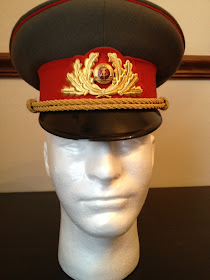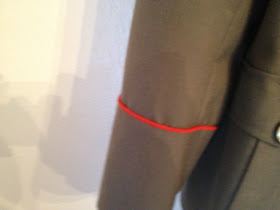The uniform displayed
here is the Dienstuniform or Service Uniform of a Generalmajor or
‘Major General’ of the East German Landstreitkräfte, the land forces of the
East German armed forces. The rank of Generalmajor in eastern militaries is equivalent
to that of an American one star Brigadier General or in British rank
equivalents a Brigadier. The uniform
jacket is the standard stone grey color of all Nationale Volksarmee uniforms
with the red colored piping of the shoulder insignia and collar bars known as
kragenspielen denoting the wearer's affiliation as a General Officer of the
East German armed forces. Generals in the East German armed forces were
signified by the wearing of the color gold in their uniform insignias. Gold
denoted a General, and silver a commissioned officer. The pants are also the
standard stone gray color as well with the reflecting red striping running
along the length of the pant leg.
As members of the 'Parteiarmee" or Army of the Party
tasked with defending the people and the Party, all officers were required to
be members of the ruling SED communist party in East Germany. Political officers
charged with indoctrination of the troops on subjects reflecting ideological,
military, and global affairs formed an essential part of Nationale Volksarmee
daily routine. These courses were known as Politische Hauptverwaltung or
'Political Main Administration'. Like the Communist parties of other allied
socialist states, the Sozialistische Einheitspartei Deutschlands known in English as the 'Socialist Unity
Party of Germany', or SED, assured complete control over the ranks by
appointing loyal party members to top positions and organizing intensive political
education for all ranks. The proportion of SED members in the officer corps
rose steadily after the early 1960s, eventually reaching almost 95 percent of
the total officer corps.
The tunic would be
worn with a white dress shirt or standard grey issue service shirt along with a dark gray tie. During periods of
warm weather, officers were presented the option of omitting the tunic, or in authorized adaptation omitting dress shirt and tie with only the jacket being worn over service trousers with the Dienstuniform.
The jacket also has a hidden loop on the interior lining for mounting the hangers for the General officer's parade dagger for certain events.
The jacket also has a hidden loop on the interior lining for mounting the hangers for the General officer's parade dagger for certain events.
Here is a picture of the stone grey pants with the red General officer's striping along the leg.
The visor cap is made
of the same gabardine material of all East German uniforms. Unlike West German
uniforms denoting branch as the central insignia and then flanked by the
national roundel, East German visor caps used the East German national insignia
as the centerpiece with the national insignia of a hammer and compass
surrounded by wreaths of wheat and German flags. Surrounding the roundel on
this example are laurel wreaths and applied with a felt background against the
face of the hat. This is unique to all General officer hats as other officers
junior in rank wore silver metal insignia. Rather than wear wreaths on the
visor like the West German's, East German officer's wore braided cords around
the cap reminiscent of styles of previous German armies. The gold coloring of
the braid and national insignia specify the wearers status as a General officer.
Shown here is the
gold metal Kragenspiegeln or collar insignia of the General Officer Corps. They
are nearly identical to the types of Kragenspiegeln worn by General officers of the earlier Nazi Wehrmacht of 1935 - 1945. The East German armed forces borrowed
heavily from the previous regime in terms of uniform style and influence all
while maintaining a sense of embracing Germanic tradition in the heavy usage
of the Prussian influence.
This picture depicts
the shoulder board insignia of a Generalmajor of the Landstreitkräfte. The
Generalmajor rank is denoted by a single five pointed silver star mounted on a
gold and silver braided shoulder cord set against a bright red base. East
German officer ranks were modelled heavily on the existing Soviet rank structure.
In German military doctrine, the rank of Generalmajor was generally that
awarded to a junior divisional commander.
The picture shown
here displays the intricate design of the
gold buttons of a General officer in the Nationale Volksarmee, bearing
the national hammer and compass insignia of the Deutsche Demokratische
Republik. The Dienstuniform consisted
primarily of a single breasted tunic with four buttons along the centerline and
corresponding buttons mounted on the pockets.
A picture of the
General Officer Corps red waffenfarbe stripe embroidered around the cuff of the
uniform sleeve.
On the right side of
the chest is an Academy badge denoting the officer school that the General
attended. The Nationale Volksarmee maintained an extensive network of schools
and academies focused on improving the technical expertise of its commissioned
officers. One of the main areas of focus with increasing responsibility was
increased focus on political reliability and the teachings of Karl Marx. Officers
becoming Generals in the East German rank structure were often sent to
educational institutions in the Soviet Union for enhanced training and language
training to become fluent in the Soviet Cyrillic language.
















Thank you very much for those references!
ReplyDelete